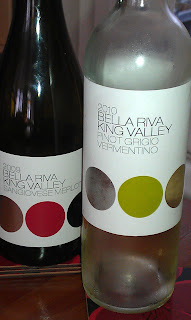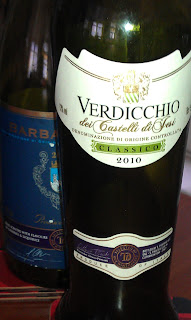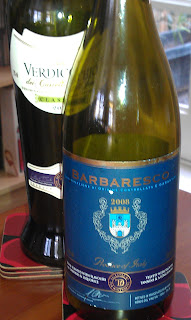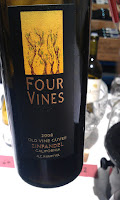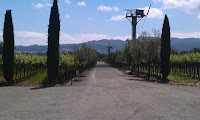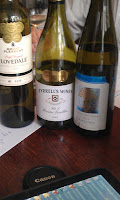As I promised (and been requested for) in my last post about
the M&S tasting, here’s a list of the wines that are suitable for
vegetarians and vegans.
Suitable for vegetarians
NV Prestige Cava Brut
NV Sparkling Burgundy
NV Oudinot Rose
Medium-Dry
NV De Saint Gall Rose
NV De Saint Gall Blanc de Blanc Premier Cru
2004 De Saint Gall
Vintage Prenier Cru Brut
NV TArlant Brut
Nature Champagne
1998 Orpale Champagne
Grand Cru
2011 Hunter Valley
Verdelho
2009 VAsse Felix
Semillon
2010 Clocktower
Sauvignon Blanc
2010 Summerer Gruner
Veltliner Langelois
2010 Verdicchio dei
Castelli di Jesi
2010 Gavi del Commune
di Gavi
2010 Belle Tour
Chardonnay
2010 Domaine
Mandeville Viognier
2008 Chablis
2007 Chablis Premier
Cru Fouchaume
2009 Pernand
Vergelesses Les Combottes
2008
Chassagne-Montrachet
2008 Vinalta Gran
Reserva Malbec
2007 Vasse Felix Cabernet
Sauvignon
2009 Clocktower Pinot
Noir
2009 Earth’s End
Pinot Noir
2008 Quinta de Fafide
2009 Balcon de la
Villa Joven
2004 Valdemadera
Grand Reserva
2007 Nero D’Avola di
Sicillia
2008 Vilalta Amarone
della Valpolicella
2007 Chateau les
Ormes
2010 Belle Tour
Cabernet Sauvignon
2010 Old Vines Grenache
Noir
2008 Cuvee Extreme
2008 Pernand
Vergelesses 1er Cru
2008 Hermits Hill
Botrytis Semillon (Desert wine)
NV Pale Cream Sherry
NV Rich Cream Sherry
Suitable for Vegans
NV Champagne de
Montpervier Blanc de Noir
2010 Tierra y Hombre
Sauvignon Blanc
2010 Cascara Limari
Valley Chardonnay
2011 Rockridge Sauvignon
Blanc
2011 Six Hats Fairtrade
Chenin Blanc
2011 Charles Back Stonedance
2011 Journey’s End
Honeycomb Chardonnay
2009 The Gum Chardonnay
2010 Seifried Nelson
Sauvignon Blanc
2010 Rabi Gruner
Veltliner Kamptal
2010 Val do Salnes
Albarino
2010 Picpoul de Pinet
(one of my favourite wines of the moment)
2010 Les Pierblancs
Sauvignon Blanc
2009 Pouilly Fume
Mathilde Favray
2010 Petit Chablis
2008 Organic Chablis
Jean-Marc Brocard
2010 Macon Villages
Uchizy
2009 Rully 1er Cru La
Pucelle
2011 Balbi Rose
2011 Burra Brook Rose
2010 Cotes du Rhone
Reserve du Boulas Rose
2010 Tierra Y Hombre
Pinot Noir
2010 Clear Lake
Merlot
2010 Six Hats Fairtrade
Shiraz
2009 Journey’s End
Beefwood Tree
2010 Hunter Valley
Shiraz
2008 Marananga Dam
GSM
2006 Marques del
Costal Conca de Barbera Costal
2008 Rioja Pago Real
2006 Pena del Inferno
2009 Baglio Rosso
Nero d’Avola
2010 Barbera d’Asti
DOC
2007 Barbaresco Cascina
Morassino
2010 Mauregard
Bordeaux
2009 Chateau Le Vieux
Pressoir
2008 Chateau Mondorion
2007 L’Etoile de
Romanin Les Baux de Provence
2009 Domaine Collonge
Crozes Hermitage
2009 Saint Joseph
2010 Beaujolais
2010 Beaujolais
Lantignie
2009 Borgogne Pinot
Noir
2009 Mercurey
2009
Chorey-les-Beaune
2009 Volnay Domaine
Roux
2009 Chambolle
Musigny
2009
Corton-Bressandes Grand Cru
1995 Vin Santo del Chianti
Rufina, Villa di Monte (Desert wine)
NV Finest Reserve
Port
2005 Late Bottled
Vintage Port
2007 Vintage Port
NV 10 Year Old Tawny
Port
I have to say I’m pretty impressed with the amount of wines that are suitable for both vegetarians and vegans, even more so that M&S
will tell you, I hope this of use to someone.














